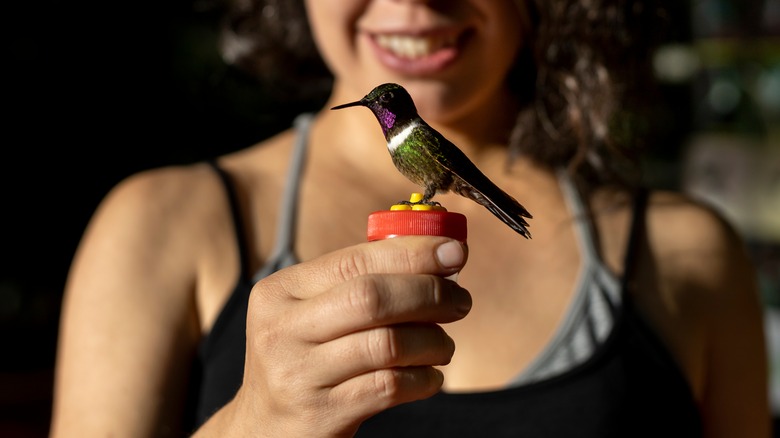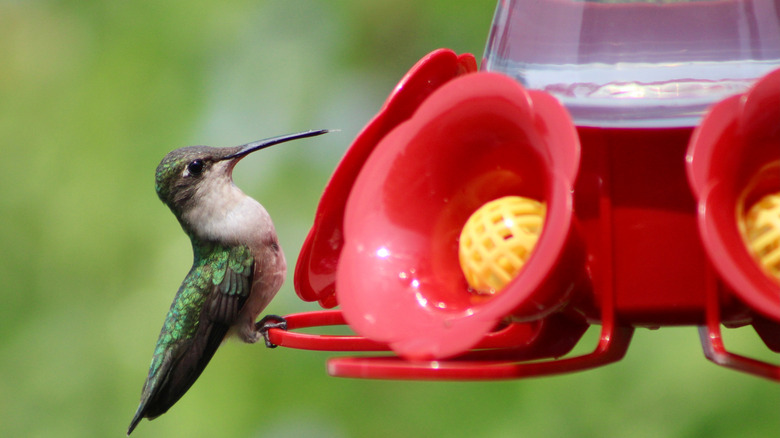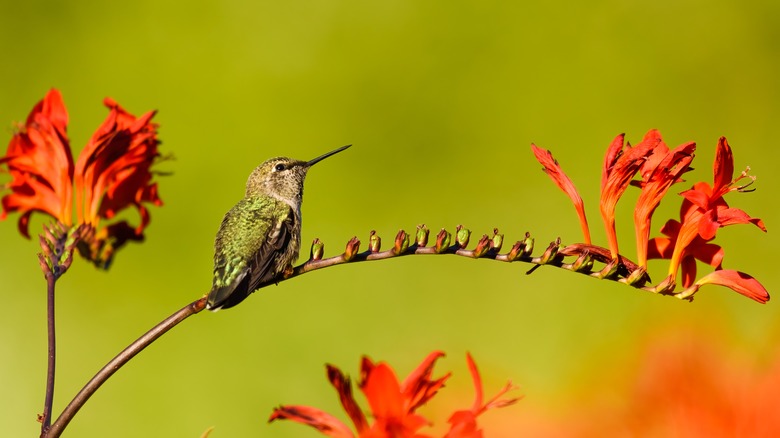How To Support Hummingbirds In Your Garden During Migration Seasons
Hummingbirds are unlike other types of birds in many ways. First, they do not travel in flocks but rather they fly solo, which is why you often only see one at a time. If you happen to see multiple hummingbirds, they're usually fighting to protect their food source. According to Kaytee, they are the only avians that can fly backward, however, their tiny legs do not allow them to walk, meaning they can only perch. Really though, who needs to walk when you can average a flight speed of 30 miles per hour? (via We Love Hummingbirds)
Hummingbirds are the smallest of all migrating birds, traveling up to 500 miles in a single trip, and they can drink the equivalent of their body weight in nectar every day. The American Bird Conservatory states there are 365 species that live in North, Central, and South America, 15 of which live in the U.S. with nine more that migrate through. Approximately 8% of hummingbird species are considered endangered or critically endangered. You can help their populations grow and thrive by offering support as they travel through your area during their spring and fall migrations.
Spring migration
Food availability is the most important factor in a hummingbird's ability to migrate to its summer destination. Ferns & Feathers recommends filling feeders with fresh nectar and placing them outside about two weeks before you expect your earliest visitors. If you're not sure when hummingbirds arrive in your area, Hummingbird Central provides a map that allows people to report sightings so you can see when the tiny fliers are headed your way.
The National Audubon Society explains that you can make your own inexpensive nectar by mixing 1 part regular white sugar with 4 parts boiling water. Stir until the sugar is completely dissolved, then let it cool. Avoid adding red dye to the mixture or substituting the white sugar with honey. The National Audubon Society notes that honey may support fungal growth, and the unnecessary coloring can harm the birds.
Another way to support migrating hummers is to leave fruit in accessible areas such as a bird bath. This will attract fruit flies, which are a beneficial source of protein. Natural nectar from flowers is, of course, going to attract more hummingbirds to your yard. Forsythia and azaleas are beautiful early blooming bushes, while bleeding hearts and columbine flowers are perennial favorites of the hummingbird.
Fall migration
Taking down your feeders before hummingbirds start their fall migration will deprive these lovely creatures of the energy they need to make it back to their winter home. In fact, RISMedia states that hummingbirds need even more food available to them in the weeks leading up to migration. Depending on where you live, it's best to keep your feeders full of fresh clear sugar water through late August or into September. If you reside in one of the southernmost states, your feeder might be the last stop before a hummingbird makes the long journey over the ocean. In those regions, go ahead and keep those feeders up until a few weeks after you have seen the last hummingbird, which could be close to late October.
Once again, flower nectar will be the most natural source of food for hummingbirds, so planting perennials that will bloom in autumn will help them prepare for their trip. Birds & Blooms suggests adding ironweed, goldenrod, pineapple sage, or blazing star to your garden since these beautiful flowers will keep blooming up until the first frost when hummingbirds will be long gone — until next year, that is.


